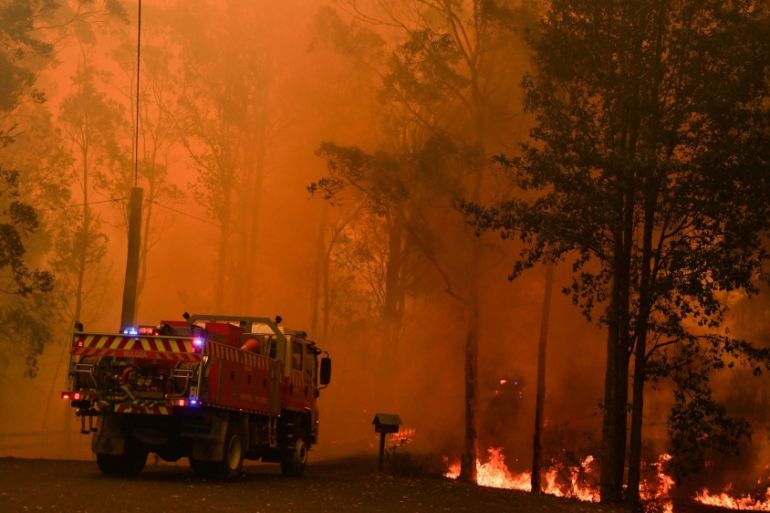Beyond Conformity: Enhancing Residential Property Security with a Detailed BAL Report
Beyond Conformity: Enhancing Residential Property Security with a Detailed BAL Report
Blog Article
The Importance of Bushfire Monitoring in Fire Defense
In the world of fire defense, the relevance of efficient bushfire administration can not be understated. As areas globally face boosting circumstances of wildfires, the proactive strategy to stop and reducing these natural disasters through tactical bushfire administration techniques has emerged as a crucial component. Past the instant danger to human life and residential property, the interplay between bushfire monitoring and ecological conservation, area involvement, and climate adjustment postures complicated challenges that need extensive services.
Value of Proactive Bushfire Avoidance
Aggressive bushfire prevention approaches are essential in mitigating the devastating impacts of wildfires on neighborhoods and ecological communities. One crucial facet of positive bushfire prevention is fuel monitoring.
Informing the public on fire safety and security methods and promoting area awareness concerning the relevance of bushfire avoidance are vital parts of aggressive techniques. Inevitably, positive bushfire prevention plays a substantial function in protecting communities and ecosystems from the damaging impacts of wildfires.
Duty of Neighborhood Involvement in Fire Protection
Engaging the area in fire defense efforts is integral to improving the performance of positive bushfire avoidance methods. Community engagement plays an important role in fostering a collective understanding of the risks postured by bushfires and the relevance of preparedness steps. By involving regional citizens, authorities can share essential information ablaze security techniques, evacuation treatments, and very early warning systems, encouraging people to take proactive actions to guard their lives and residential or commercial properties.
By fostering a society of preparedness and cooperation, areas can strengthen their capacity to react successfully to bushfire emergency situations, reducing the impact on residential properties and lives. Ultimately, area involvement is a foundation of extensive fire protection strategies, stressing the relevance of collective activity in guarding prone locations from the risk of bushfires.
Relevance of Wildlife Conservation in Bushfire Management
Conservation of wildlife plays a critical duty in efficient bushfire administration methods, guaranteeing the security of diverse ecosystems and biodiversity in fire-prone areas. Wild animals preservation is crucial as it contributes to the general durability of environments, helping in their capability to recuperate and stand up to from the effect of bushfires. By preserving habitats and safeguarding various species, the all-natural equilibrium within these ecosystems is preserved, which is important for their lasting wellness and sustainability.
In addition, wildlife preservation additionally aids in minimizing the risk and strength of bushfires. Healthy communities with well-preserved wild animals populations can serve as natural firebreaks, reducing the spread of fires and restricting their destructive potential (BAL Assessment). Specific animal varieties, like delving animals or birds that spread out seeds, play distinct roles in assisting or stopping fires in the post-fire regrowth of environments
Including wildlife preservation right into bushfire management techniques is not just essential for protecting biodiversity but additionally for promoting the general wellness and strength of ecological communities when faced with raising fire risks.
Benefits of Strategic Fuel Decrease Programs
Tactically carrying out gas reduction programs is necessary in alleviating the threat and effect of bushfires in fire-prone areas. These programs include regulated burning, mechanical cleaning, and other approaches to minimize the amount of combustible vegetation offered to sustain wildfires. By purposefully lowering fuel loads in key areas, such as close to domestic communities or vital facilities, Bonuses the intensity and spread of bushfires can be dramatically reduced.
Among the primary benefits of gas decrease programs is the enhancement of general fire durability in an ecosystem. By producing tactical fuel breaks and reducing the connection of greenery, these programs assist to interrupt the path of a bushfire, making it easier for firemens to extinguish the blaze and contain. Additionally, gas reduction programs can protect biodiversity by protecting against excessively intense fires that can ravage habitats and endanger wildlife populations.
In addition, these programs can also guard human lives and residential or commercial property by decreasing the threat of catastrophic fires that pose a substantial threat to neighborhoods. Inevitably, critical fuel decrease programs play a vital function in proactive bushfire management and fostering a much safer setting for both people and nature.
Effect of Environment Modification on Bushfire Threat

Greater temperatures result in drier plants, making it extra susceptible to ignition. Reduced rainfall in specific regions extends dry spell conditions, additionally enhancing the flammability of the landscape. In addition, the transforming climate has altered wind patterns and climatic problems, resulting in more unpredictable fire actions and rapid fire spread.
As the environment remains to change, the regularity and strength of bushfires are anticipated to climb, requiring a flexible and positive approach to bushfire monitoring. Approaches have to progress to represent the changing danger landscape, incorporating go to website climate estimates and taking into consideration long-lasting strength in fire monitoring preparation. Addressing the impact of climate modification on bushfire risk is critical in developing effective approaches to protect lives, property, and the setting.
Verdict
In final thought, aggressive bushfire avoidance, neighborhood engagement, wild animals preservation, critical fuel reduction programs, and factor to consider of climate adjustment are crucial elements in reliable fire defense. By applying these approaches, we can much better manage bushfire threats and secure both human lives and the environment. Bushfire Management Plan. It is critical that stakeholders collaborate to focus on these procedures to minimize the terrible effect of bushfires on neighborhoods and ecosystems

As the environment proceeds to transform, the regularity and intensity of bushfires are expected to increase, demanding a proactive and adaptive method to bushfire administration.In final thought, proactive bushfire prevention, neighborhood involvement, wild animals preservation, critical gas decrease programs, and factor to consider of climate change are critical components in reliable fire visit security.
Report this page